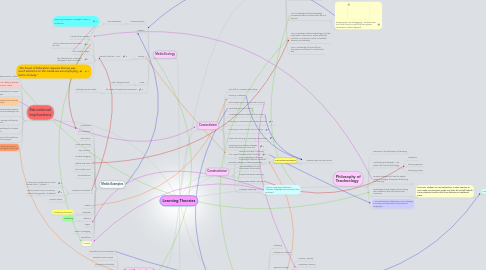
1. Educational Implications
1.1. More Resources to Master
1.2. Develop an Ability to Discern Useful forms of Media
1.3. More Opportunities to Connect with Students
1.4. Education becomes less private and more public
1.5. Knowing students personally helps to understand their prior knowledge and interests
1.6. Technical Training of Students and Teachers
1.7. Higher Expectations for Student Engagement
1.8. Skills required in the workforce are more technological
1.9. Give students choice in technology that they use
2. Media Ecology
2.1. Communication
2.1.1. Documentaries
2.1.1.1. Giving Deeper Insight Into a Culture
2.2. Medium
2.3. History
2.3.1. Marshall Mcluhan - 1977
2.3.1.1. Media is the Message
2.3.1.2. "Some Media are Cool and Some are Hot"
2.3.1.3. The Global Village
2.3.1.4. the alternative to violence is dialogue (a form of media)
2.3.1.5. "the future of Education requires that we pay much attention to the media we are employing, as forms of study"
2.4. Verve
2.4.1. How Things are Said
2.5. The Study of Media as Environment
2.5.1. Anything Can Be Media
3. Social Construction of Technology (SCOT)
3.1. Shaped by Human Interests
3.2. Relevant Social Groups
3.3. Interpretive Flexibility
3.4. Design Flexibility
3.5. Problems and Conflicts
3.6. Closure
3.6.1. Rhetoric Closure
3.6.2. Redefinition of the Problem
3.7. Criticism
4. Media Examples
4.1. Whiteboard
4.2. SMARTboard
4.3. Wall Charts
4.4. Audio Recordings
4.5. Flip Cameras
4.6. Student Blogging
4.7. Tablets and iPads
4.8. The Printed Word
4.9. The Telephone
4.10. Television and Radio
4.10.1. "I think radio people are far more literate than TV people..."
4.10.2. Sports events have no meaning without being public.. broadcast
4.10.3. Sesame Street
4.11. Twitter
4.12. Wikipedia
4.12.1. Validating Information
4.13. Artforms
4.13.1. Advertising
4.14. Skype
4.15. Instant Messaging
4.16. eportfolios
4.17. Youtube
5. Connectivism Examples
5.1. Massive Open Online Course
6. Connectivism
6.1. The Skill of Accessing Information
6.2. Forming a Network
6.3. Not Everything Can Be Learned at Once
6.4. Contributing to the Network
6.5. Knowledge Exists Outside of the Learner
6.6. Learning is Connecting Information Sources
6.7. Learning Is More Critical Than Knowing
6.8. Continual Learning = Nurturing Connections
6.9. Perceiving Connections Between Fields and Ideas is a Core Skill
6.10. The Value of Currency and Accuracy
6.11. Decision Making Is a Learning Process
7. Constructivism
7.1. Learners Construct Meaning
7.2. Prior Knowledge Influences Knowledge Learners Construct
7.3. Accommodation of New Inconsistent Information
7.4. Project/Task Based Learning
7.5. Community Based Learning
7.6. Authentic Learning
7.6.1. Within a Language Classroom - Authentic language sources rather than contrived
8. Cognitive Load Thoery
8.1. Chunking
8.2. Extraneous Material
8.3. Types of Memory
8.3.1. Sensory Memory
8.3.2. Temporary Memory
8.3.3. Working Memory
8.3.4. Long Term Memory
8.4. Overloading Working Memory
8.5. Unlimited Long Term Memory
8.6. Schemata
8.6.1. Working memory builds schemata into long term memory
8.7. Automaticity
9. Student Learning
9.1. Student Directed
9.2. Teacher Directed Activities
9.3. Student Engagement
9.4. Multiple Inteligences
9.4.1. Interactional Intelligence
9.4.2. visual Intelligence
9.5. In Groups
9.6. In Private
9.7. Building On Previous Knowledge
9.8. Exploring the Environment
10. Philosophy of Teachnology
10.1. Precursor is the philosophy of teaching
10.2. My teaching philosophy + my view of the role of technology
10.2.1. classroom
10.2.2. learning process
10.2.3. teaching process
10.3. Personal viewpoint of how the digital medium changes all aspects of teaching and learning
10.3.1. Digital technology enables/increases peer learning/editing
10.4. Technological and Digital Literacy along with traditional forms of literacy and numeracy
10.4.1. Not every student can use Photoshop, a video camera, or even make a PowerPoint. Make sure they do not fall behind! These students usually suffer from illiteracy in traditional areas.
10.4.1.1. Meet Student Needs
10.5. A new philosophy addressing current changes in society and expectations of potential employees
11. TPACK
11.1. It builds on the idea of Pedagogical Content Knowledge
11.2. Proposed by Mishra and Koechler, 2006
11.3. 4 Components Interacting
11.3.1. Pedagogical Knowledge (PK)
11.3.2. Content Knowledge (CK)
11.3.3. Technological Knowledge (TK)
11.3.4. Context
11.4. PCK: Knowledge of pedagogy specific to the teaching context.
11.5. TPACK Ven Diagram
11.6. TCK: knowledge of how technology increases access to content and how it is learned
11.6.1. Requiring the use of Blogging - students now must learn how to install and use Spanish characters on their keyboard.
